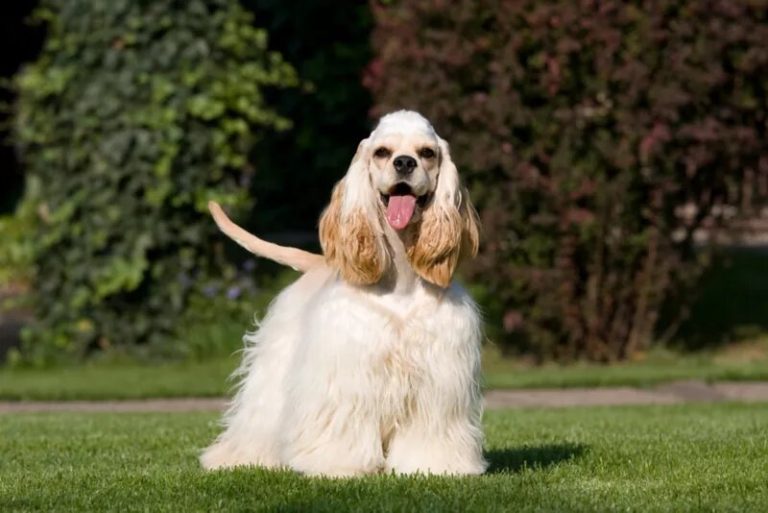About Cocker Spaniels

Health
The Cocker Spaniel’s national parent club, the American Spaniel Club, has a health committee that looks at breed health issues and makes recommendations to breeders for required health testing.The Cocker Spaniel has good longevity. A conscientious breeder can furnish records of the sire’s and dam’s health testing, for example for hips, patellas, and eyes. Breeders often have years of data regarding testing done in these health areas. Learn from the veterinarian proper procedures to clean the Cocker’s ear canals on a regular basis, especially following a bath, in order to avoid infections. Thorough grooming of the Cocker coat will aid in preventing mats, which can precipitate skin problems underneath.
Grooming
Cocker Spaniels require regular, thorough grooming. Sessions missed are not easily made up and may result in tangles or mats in the Cocker’s coat. A metal, professional-quality dog comb with fine and medium spacing for the teeth is a necessity. You can follow combing with a gentle slicker brush, but the comb is key. Loose hair should be carefully removed with the comb, making sure you are clear and can see through to the skin everywhere. If you encounter snarls, do not pull through; rather, pick snarls apart, starting at the tips of the coat and then comb through. Be cautious when combing ears; the skin at the edges is thin and can be pierced by too-vigorous combing. The Cocker requires thorough bathing with quality dog shampoo. Thorough rinsing and re-rinsing are crucial, as soap residue can cause skin irritation. Dry carefully with a blow-dryer on not too hot a setting. Learn the procedure for cleaning and drying the ear canals. During bathing, check the Cocker’s skin for any inflamed spots and get treatment. It is key to learn grooming procedures yourself and/or enlist the services of a professional groomer who likes and is experienced in grooming the breed.
History
The spaniel is a breed type of great antiquity, believed to have originated in Spain (the words “Spain” and “spaniel” being closely related). Spaniels have been bird hunters’ helpers since before the development of the rifle, when hunting dogs were used in tandem with nets.
For centuries, European and British spaniels were informally grouped as simply land spaniels and water spaniels. By the 19th century, however, when written breed standards, dog shows and field trials, and the very notion of purebred dogs began to gain traction in England, the various spaniels were classified as specific breeds. Among them was the Cocker, so called because they specialized on woodcock. These dogs, smaller than English Springer Spaniels but larger than English Toy Spaniels, were the ancestors of the modern Cocker Spaniel.
In America, the Cocker Spaniel diverged into two varieties, American and English. The English was characterized as being taller and with a longer head than its American cousin, with a coat that was not as profuse. The English and Canadian kennel clubs registered the varieties as separate breeds beginning in 1940, and the AKC followed suit in 1946. The AKC breed names are the Cocker Spaniel (for the U.S. type) and the English Cocker Spaniel (for the British type).
A black Cocker named Brucie helped popularize the breed by twice winning Westminster’s Best in Show, in 1940 and ’41, but the Cocker’s American heyday came in the 1950s. The Cocker was the AKC’s most popular breed of the decade. It was the era of Disney’s “Lady and the Tramp” and Vice President Richard Nixon’s Cocker, named Checkers, who helped change the course of U.S. political history.

Nitrition
Selecting the best diet can be a matter of trial and for the individual dog. The key is to pay attention to food labels for quality ingredients. The owner can seek advice from their dog’s veterinarian regarding any particular sensitivities or needs the Cocker has. Choose a high-quality food and give it a fair tryout. A chicken and rice’¿based food has long been a good starting point for Cocker food trials, but consider individual sensitivities, likes, and needs. Maintain proper weight, but be careful not to overfeed. Groomers and veterinarians often see overweight Cockers.
Training
Regarding training the Cocker Spaniel, the good news is that in general this is a people-pleasing breed. They want to be ‘good’ in order to please their people, and they are generally sensitive and responsive to correction and a disapproving tone in their owner’s voice. Harsh means of correction are not usually warranted, nor are they productive in the Cocker. The breed enjoys the challenge of performance activities, and it is a good idea to try out the available activities and events to see what interests your individual Cocker and follow through with training. Early socialization and puppy training classes are recommended. Cockers are rather easily motivated with food rewards and with play and praise.

